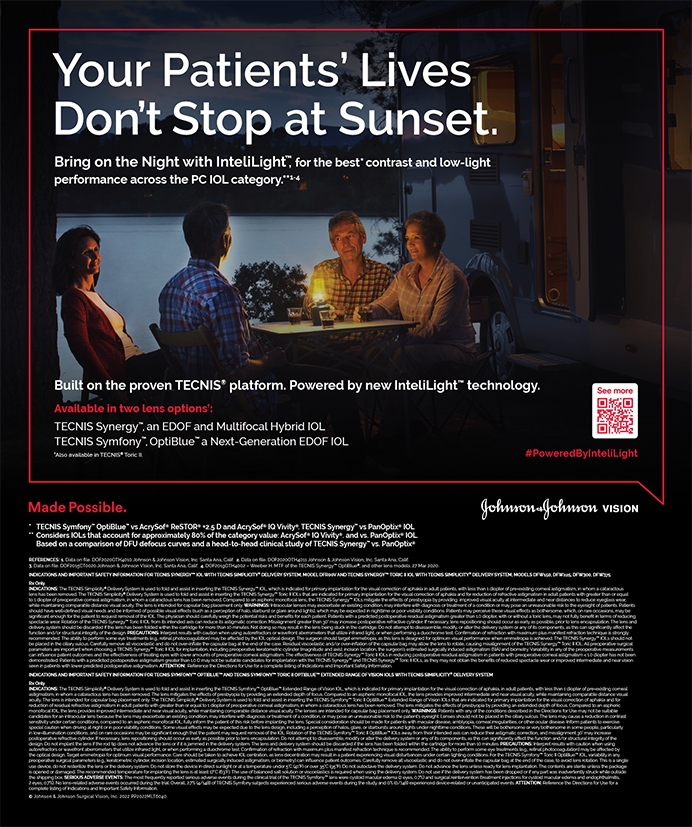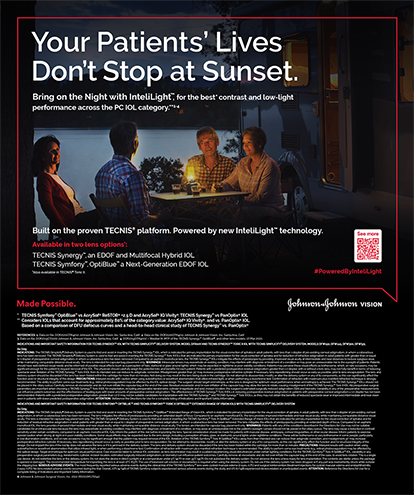During the preoperative examination of patients who will undergo anterior segment surgery, I make a concerted effort to identify symptoms of preexisting dry eye, even if my clinical evaluation does not reveal the signs of dry eye. The "disconnect" between the signs and symptoms of this disease is well known. I ask patients a series of questions, perform an examination, and then, if dry eye disease is present, recommend various treatment regimens to alleviate the disease's symptoms.
QUESTIONS TO ASK PATIENTS
I ask patients several questions designed to discover preexisting dry eye disease. Were you ever contact lens intolerant? What time of day do your eyes look and feel their worst? Do you ever have to stop reading or watching TV in the evenings because your eyes are too tired? Do you have fluctuating vision, especially in the evenings? Do your eyes ever burn, sting, tear, and/or become red, especially in the afternoon/evening? If the patient's eyes feel worst in the morning, the problem is usually blepharitis. If his eyelids are also crusty and/or swollen in the morning, it is almost certainly blepharitis. Dry eyes, however, get worse as the day goes on. If a patient has symptoms in the morning and then again in the evening, he probably has blepharitis and dry eyes—two conditions that are often concomitant.
EVALUATION AND TREATMENT REGIMEN
At the slit lamp, I look at the tear breakup time, corneal staining, and the height of the tear meniscus; liquid fluorescein drops are useful for all of these evaluations. I use lissamine green or rose bengal to detect interpalpebral conjunctival staining. A Schirmer test is also useful in diagnosising dry eye.
If I identify dry eye based on either the patient's history (answers to the aforementioned questions) or the examination, I pursue aggressive treatment in both eyes with one drop of Restasis (Allergan, Inc., Irvine, CA) b.i.d. and one drop of Lotemax (Bausch & Lomb, Inc. Rochester, NY) q.i.d. for 2 weeks, then tapered to b.i.d. for 2 weeks. I also prescribe a gently preserved artificial tear such as Optive (Allergan, Inc.), Blink Tears (Abbott Medical Optics Inc., Santa Ana, CA), or FreshKote (Focus Laboratories, Inc., North Little Rock, AR). For more severely dry eyes (grade 3 on the International Task Force Scale), I will prescribe an unpreserved tear for both eyes such as Optive Sensitive (Allergan, Inc.), preservative-free Blink Tears (Abbott Medical Optics Inc.), or Refresh Plus or Celluvisc (both from Allergan, Inc.). With each of these drugs, the patient administers one drop four to eight times daily (I guide them on the dosing) and as needed.
In addition, I instruct patients to use a bland ointment at night such as Refresh PM (Allergan, Inc.). My recommended dose is a 1-inch strip in the inferior cul de sac no sooner than 15 minutes after the instillation of Restasis. I also suggest that they take a nutritional supplement containing omega-3 fatty acids, such as TheraTears Nutrition Gel Caps (Advanced Vision Research, Woburn, MA) or the dry eye supplements from LifeGuard Health PRN, LLC (Plymouth Meeting, PA).
I usually instruct patients with concomitant blepharitis to perform lid soaks and scrubs b.i.d. I also prescribe bilateral treatment with azithromycin ophthalmic solution 1% (AzaSite; Inspire Pharmaceuticals, Inc., Durham, NC) b.i.d. for 2 days, followed by q.h.s. for 28 days.
FOLLOW-UP CARE
I generally ask patients to return within 4 to 6 weeks after starting therapy for a follow-up examination. If their dry eye symptoms have improved but not completely resolved, I place two or four punctal plugs, depending on the severity of the dryness. I currently favor Snug Plugs (FCI Ophthalmics, Inc., Marshfield Hills, MA) and Form Fit (Oasis Medical, Inc., Glendora, CA). The former are silicone "collar button" plugs, which are preloaded in a stretched position so that they fit in virtually any punctum. Form Fit are intracanalicular plugs made of desiccated hydrogel; they swell to several times their size during the first few minutes after insertion. In the vast majority of cases, the patient is now ready for anterior segment surgery.
SURGICAL CONSIDERATIONS
It is important to keep the epithelium moist intraoperatively. Any inadvertent epithelial defects may be treated with a bandage soft lens for 24 to 48 hours postoperatively. My favorite is the AcuVue Oasys (Johnson & Johnson Vision Care, Inc., Jacksonville, FL).
After surgery, patients should continue their prescribed dry eye therapy for 3 months. I taper treatment on an individual basis, although Restasis is the mainstay of dry eye treatment and is continued for the long term by most of my patients.
Marguerite B. McDonald, MD, is a cornea/refractive specialist with the Ophthalmic Consultants of Long Island in New York, a clinical professor of ophthalmology at the NYU School of Medicine in New York, and an adjunct clinical professor of ophthalmology at the Tulane University Health Sciences Center in New Orleans. She is a consultant to Abbott Medical Optics Inc. and Allergan, Inc. Dr. McDonald may be reached at (516) 593-7709; margueritemcdmd@aol.com.


